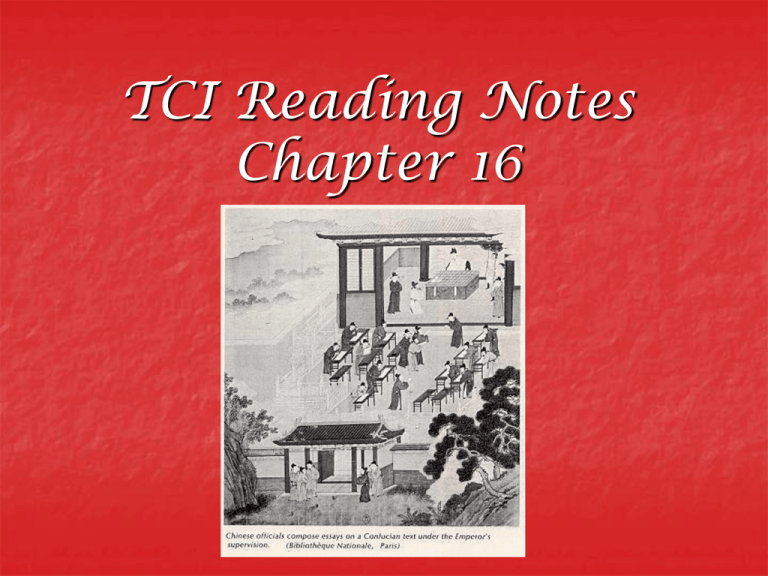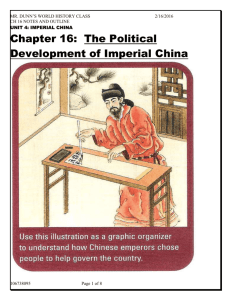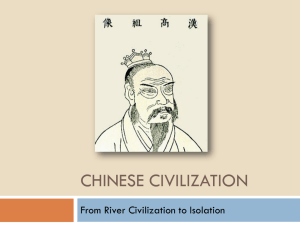TCI Reading notes 16-17
advertisement

TCI Reading Notes Chapter 16 16.2 The Government of Imperial China 1. 2. 3. People can overthrow an emperor when he rules badly. A bureaucracy is an organized group of government officials. When the bureaucracy became corrupt, people suffered from high taxes, forced labor, and attacks by bandits. When the Han dynasty fell, China broke into separate kingdoms. It was reunited by the Sui dynasty. 16.3 Aristocracy: The Tang Dynasty Reproduction of Cell Used by Students Taking the Imperial Exams 1. 2. 3. Scholar-officials were scholars who got government jobs through examinations. The examination was primarily based on the teachings of Confucius. Only the wealthy could afford the tutors, books, and time to study needed to prepare for the exams. Confucius 16.4 Meritocracy: The Song Dynasty Song Dynasty scholars 1. 2. 3. Government officials who had studied Confucius would be rational, moral, and able to maintain order. People from lower classes were allowed to become government officials. People wanted these jobs because government officials were respected and were excused from taxes and military service. 16.5 Government by Foreigners: The Period of Mongol Rule Kublai Khan 1. 2. He appointed relatives, other Mongols, and trusted foreigners. Chinese scholars worked only as teachers and minor government officials. 16.6 The Revival of the Civil Service System 1. 2. Hiring scholars emphasized moral behavior, justice, kindness, loyalty to the emperor, proper conduct, and the importance of family. It insured that officials were trained and talented, and it allowed the ambitious and hard working from all classes the chance to succeed. People who knew science, mathematics, or engineering were kept out of government. Because Confucian scholars had little respect for merchants, trade and business were not encouraged. TCI Reading Notes Chapter 17 AGRICULTURE COMMERCE URBANIZATION 17.2 Changes in Agriculture 1. 2. 3. 4. 5. Cotton, sugar, tea, and mulberry trees were grown. A new kind of fast growing, drought-resistant rice was grown. Rice plants began to be grown in seedbeds. Rice was transplanted to paddies. Rice growing took a lot of work done by many people. 17.2 Changes in Agriculture 1. 2. 3. 4. Improved plows and harrows were used. Crops were grown on terraced hillsides. Chain pumps were used for irrigation. Water buffalos pulled plows. 17.2 Changes in Agriculture Agriculture changed in China from the 10th through the 13th centuries because 1. 2. 3. 4. Farmers moved to the south, a good region for growing rice. A new type of rice was introduced. An improved plow and harrow were developed. Farmers fertilized their crops. 17.3 The Growth of Trade and Commerce 1. 2. Goods were moved along canals on barges. Junks were used for trade with foreign cultures. 17.3 The Growth of Trade and Commerce 3. 4. 5. Peasants sold surplus crops, animals, and goods they made at home. Indigo, spices, silver, ivory, and coral were imported. Oxcarts and pack animals moved products along roads. 17.3 The Growth of Trade and Commerce 6. 7. Small shops lined streets and bridges. People used paper money and traded in copper coins at deposit shops. 17.3 The Growth of Trade and Commerce Commerce developed in China from the 10th through the 13th centuries because 1. 2. 3. 4. There was a vast system of rivers and canals, Improvements in navigation made long sea voyages easier, Wealthy landowners demanded more goods Paper currency helped trade. 17.4 Urbanization 1. 2. 3. 4. 5. 6. 7. 8. Restaurants, wine, and teahouses provided food and drink. Vendors sold food from trays on their heads. Silk, silver, fans, and other items were for sale. Signs identified the many goods being sold. There were theaters and outdoor entertainers. Urban women had less status than the rural women. Chinese cities were the largest in the world. Cities were crowded and exciting. Many types of people live in the city. 17.4 Urbanization Cities developed from the 10th through the 13th centuries in China 1. 2. People came to the city to trade as commerce increase. Large landowners moved to cities because they preferred the shops and social life there.











